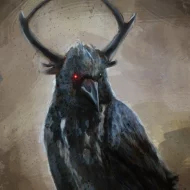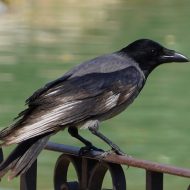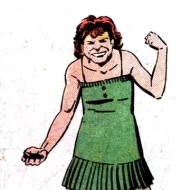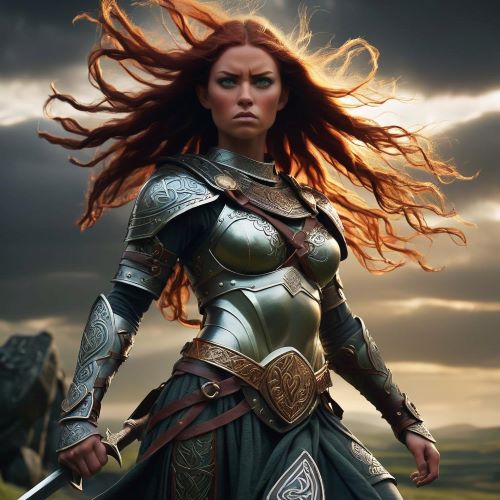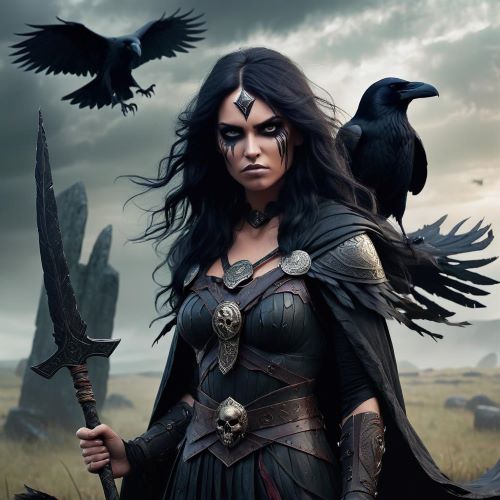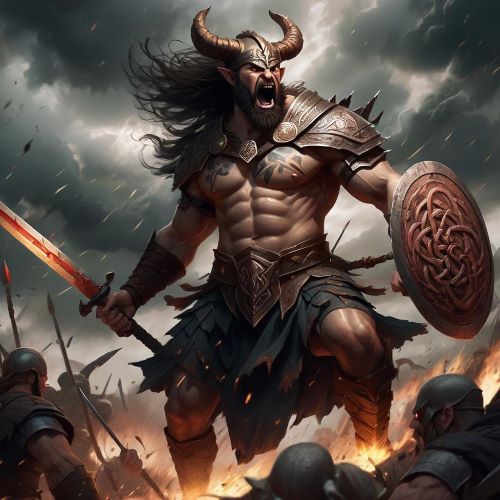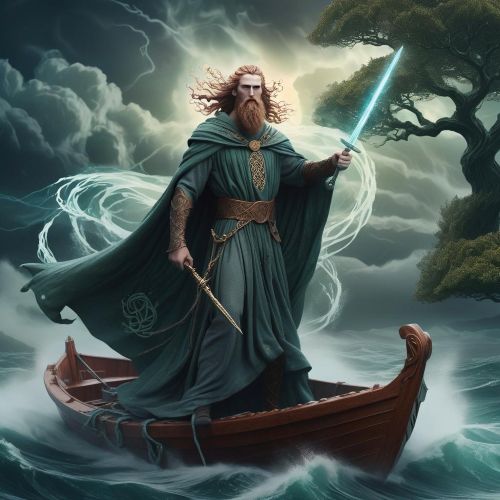Badb : The Death Bringer
Listen
At a glance
| Description | |
|---|---|
| Origin | Celtic Mythology |
| Classification | Gods |
| Family Members | Ernmas (Mother), Cailitin (Father), Neit (Husband), Dagda (Husband), Macha, Nemain, Anand (Sisters) |
| Region | Ireland |
| Associated With | Death, Screams |
Introduction
In Irish mythology, Badb (pronounced “Bive”) is one of the most haunting and powerful figures, a goddess of war, prophecy, and death who often takes the form of a crow. Her name literally means “battle crow,” and she appears on battlefields as both a harbinger of doom and a manipulator of chaos. Badb’s terrifying presence was often seen as a sign that slaughter and defeat were imminent. In medieval texts, she is described as a hideous hag foretelling the downfall of heroes or as a spectral woman performing ominous acts, such as washing the bloody armor of warriors fated to die — a vision that echoes the later figure of the banshee.
Badb appears in the tale Togail Bruidne Dá Derga, where she predicts the tragic death of Conaire Mór. In another story, she is described as washing the chariot of the warrior Cormac, an ill-fated omen. Her eerie cries and visions marked her as a goddess tied to fate, destruction, and the thin veil between the living and the dead.
Physical Traits
Badb’s appearance was as shifting and unsettling as her nature. She was most often envisioned as a crow flying above battlefields, circling over warriors and shrieking prophecies of death. At other times, she appeared as a withered old hag, reinforcing her association with decay and mortality. Scholars often connect her to the crone aspect of the Morrígan, though in certain traditions she could also appear as a young woman, highlighting her fluidity of form.
Her terrifying cries struck fear into soldiers, causing panic and confusion among enemy ranks. The sight of a crow hovering over the battlefield was believed to be an omen of defeat, with Badb herself guiding the chaos of war.
Family
Badb is usually counted as one of the Morrígan, the trio (sometimes more) of goddesses of war, fate, and sovereignty. Her sisters include Macha and Nemain, while other traditions expand the group to include Anand, Banba, Fodla, and Ériu, the latter three being personifications of Ireland itself. Her mother, Ernmas, was a goddess linked to fertility and agriculture, while her father, Cailitin, is sometimes described as a druid.
In myth, Badb was said to be the wife of Neit, the god of war, although in some versions she was linked to Tethra, a Fomorian ruler associated with the Otherworld. Her relationships and associations highlight her role not just as a war goddess but as a figure tied to sovereignty and the cyclical destruction that makes renewal possible.
Other Names
The name Badb in Old Irish translates to “battle crow” and carries deep symbolic weight. She is also known as Badb Catha, which reinforces her identity as the crow of battle. Linguists trace the word back to the Proto-Celtic root bodwos, meaning “battle,” which also influenced Germanic and Norse words for war, such as the Old Norse bǫð. These linguistic echoes show how widespread the symbolic link between carrion birds and warfare was across Indo-European cultures.
Powers and Abilities
Badb’s powers were rooted in prophecy, fear, and chaos. She was said to appear before battles to predict their outcome, foretell the deaths of kings and warriors, and sow panic among armies. Her shrieks were so terrifying that they could scatter troops before swords were even drawn.
Like the banshee of later Irish folklore, Badb’s wailing cries served as omens of death. She was not merely a passive seer but often an active participant in combat, stirring confusion and bloodlust in the hearts of warriors. She represented the inescapable truth of mortality — that war consumes all, and even the greatest heroes cannot escape their fate.
Modern-Day Influence
Though an ancient goddess, Badb’s influence lingers in folklore, literature, and popular culture. Her image as a crow of doom has shaped the archetype of the banshee, whose mournful wails foretell death in Irish tradition. In literature, she appears alongside her sisters in works like Robert E. Howard’s The Phoenix on the Sword and Michael Scott’s Secrets of the Immortal Nicholas Flamel. Charles Moore also references her in A Dirty Job, where she embodies the dark humor of mortality.
In modern Pagan and Celtic spiritual practices, Badb is sometimes invoked as a goddess of transformation, prophecy, and the shadow side of life. Her enduring presence shows that humanity remains fascinated by figures who embody both the terror and inevitability of death.
Related Images
Sources
Borsje, J. (1996). From chaos to enemy: Encounters with monsters in early Irish texts. An Sagart.
Britannica. (n.d.). Badb: Celtic goddess. In Encyclopedia Britannica. Retrieved September 16, 2025, from https://www.britannica.com/topic/Badb
Condren, M. (1989). The serpent and the goddess: Women, religion, and power in Celtic Ireland. New Island Books.
Green, M. (1992). Dictionary of Celtic mythology. Thames & Hudson.
Herbert, M. (1996). Goddess and king: The sacred marriage in early Ireland. Ériu, 47, 1–27.
Leahy, M. (1988). The phenomenon of the Badb in Irish tradition. Éigse: A Journal of Irish Studies, 22, 37–52.
Mark, J. J. (2019, March 20). The Morrigan: Celtic goddess. World History Encyclopedia. Retrieved September 16, 2025, from https://www.worldhistory.org/Morrigan/
Ó hÓgáin, D. (1999). The sacred isle: Belief and religion in pre-Christian Ireland. Boydell & Brewer.
Sjoestedt, M. L. (1940). Dieux et héros des Celtes [Gods and heroes of the Celts]. Mythos.
Wood-Martin, W. G. (1902). Traces of the elder faiths of Ireland: A folklore sketch. Longmans, Green & Co.
Frequently Asked Questions
What does Badb mean?
Badb means “battle crow” in Old Irish, symbolizing both the goddess of war and the ominous crow associated with death and prophecy on the battlefield.
How do you pronounce Badb in Irish?
Badb is usually pronounced “Bive” in Irish, with the final -db sounding like a soft -v.
What is Badb the god of?
Badb is a goddess of war, death, and prophecy in Irish mythology, often appearing as a crow to foretell doom and influence battles.
Is Badb part of the Morrígan?
Yes, Badb is one aspect of the Morrígan, a trio of war goddesses in Irish mythology, alongside Macha and Nemain.
What symbols are associated with Badb?
Badb is strongly linked with the crow and raven, symbols of death, prophecy, and the chaos of battle.


